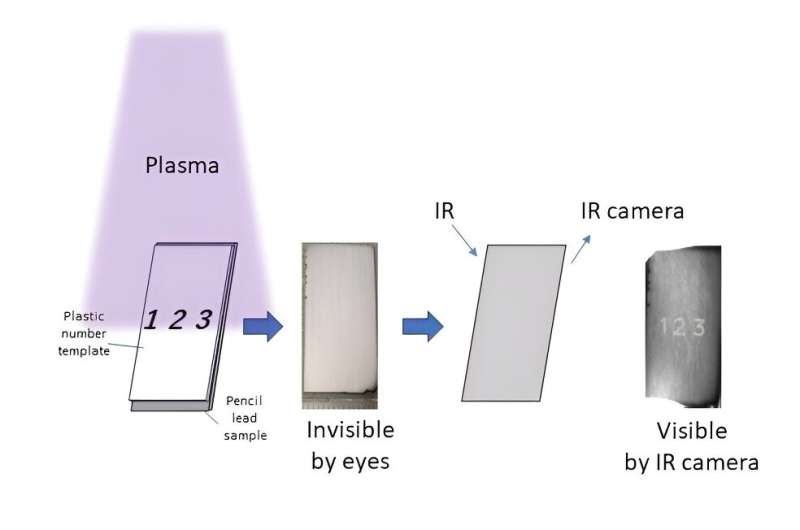This article has been reviewed according to Science X's editorial process and policies. Editors have highlighted the following attributes while ensuring the content's credibility:
fact-checked
trusted source
proofread
Repurposing pencil lead as an optical material using plasma

Optical materials are essential in many modern applications, but controlling the way a material reflects light on its surface is costly and difficult. Now, in a recent study, researchers from Japan found a simple and low-cost way of tuning the reflectance spectra of pencil lead samples using plasma. Their technique enabled them to produce pencil lead with various structural colors and even print invisible characters that can only be seen using an infrared camera.
By interacting with light in predictable ways, optical materials have paved the way for all sorts of modern technologies, from industrial sensing, Organic Light-Emitting Diode or OLED displays, and telecommunications to even cancer treatment. In many of these applications, controlling the frequencies of light absorbed and reflected by these materials is essential.
However, one pressing problem with optical materials is their relatively high cost. To ensure their proper functioning, optical materials often require complex manufacturing steps and a stringent quality control process.
Moreover, research and development efforts also tend to be expensive, especially for the more niche applications. On top of this, the present overreliance of optical materials on scarce substances like rare-earth elements means their production will not be sustainable in the long run.
To this end, Professor Hiroshi Moriwaki from the Department of Applied Biology, Faculty of Textile Science and Technology along with Associate Professor Shouhei Koyama from the Department of Advanced Textile and Kansei Engineering, Faculty of Textile Science and Technology, both at Shinshu University, have been working hard to find a breakthrough. Over the past few years, their research group has been investigating the potential use of pencil lead, one of the simplest and most widely available materials, as an optical material.
In their latest study published in Optical Materials, they reported a recent breakthrough that could revolutionize this field.
But how does one transform pencil lead into useful optical materials? The answer boils down to one word: plasma, an electrically charged gaseous state.
"We previously reported that by irradiating pencil lead with plasma, it is possible to control the reflection of light in the visible light range and create various 'structural colors.' These structural colors form due to a phenomenon known as thin-layer interference between clay and graphite, which are the two main components of pencil lead," explains Prof. Moriwaki,
"In the proposed approach, the removal of graphite from the surface of pencil lead via plasma etching exposes the underlying clay, which acts as a thin layer."
Building upon these previous findings, the researchers investigated the effect of longer durations of plasma irradiation on lead. To this end, they prepared pencil lead samples and placed them in a plasma chamber for different periods of time, ranging from ten seconds to over three minutes. Afterwards, they measured the changes in the reflectance spectra of the samples, that is, the intensity at which each processed sample reflects incident light depending on its frequency.
The researchers found that irradiating pencil lead with plasma for extended periods of time resulted in a novel optical material that causes interference in the near-infrared and mid-infrared ranges, which are below the wavelength region of visible light. This was due to the larger thickness of the clay layer exposed by plasma etching.
To showcase a notable application of their technique, the team etched letters and numbers onto the surface of a pencil lead slab in such a way that the symbols would only be visible when using an infrared camera.
Overall, this study hints at a new and exciting method to produce optical materials at a much-reduced price. "The aim of this research is to establish a method to utilize an old material, such as pencil lead and transform it into a new optical material," says Prof. Moriwaki.
"Our method uses only pencil lead as a starting material, which is extremely environmentally friendly. It would be great if this strategy could be applied to printers to develop completely new and sustainable printing technologies."
The researchers hope these efforts will lead to more affordable optical materials and perhaps even new ways to print.
More information: Tomoya Kamine et al, Pencil lead etched by plasma: Novel photonic material that can control the reflection from the visible to the infrared region, Optical Materials (2024). DOI: 10.1016/j.optmat.2024.115777
Provided by Shinshu University




















